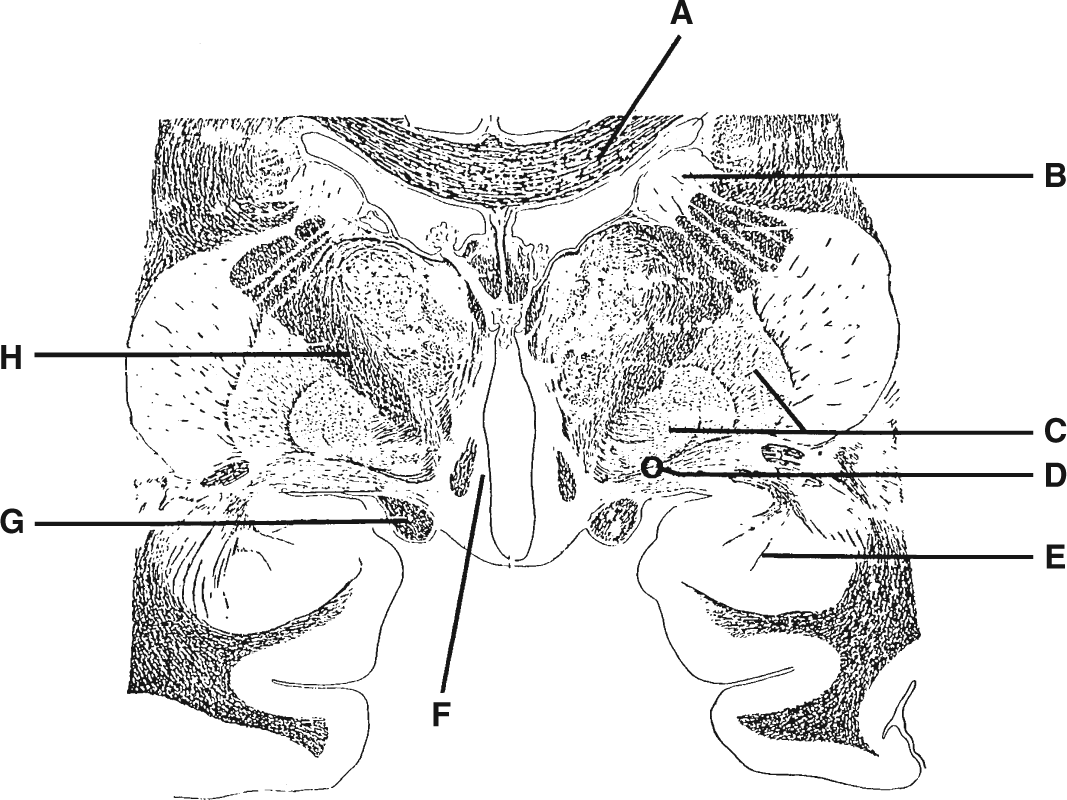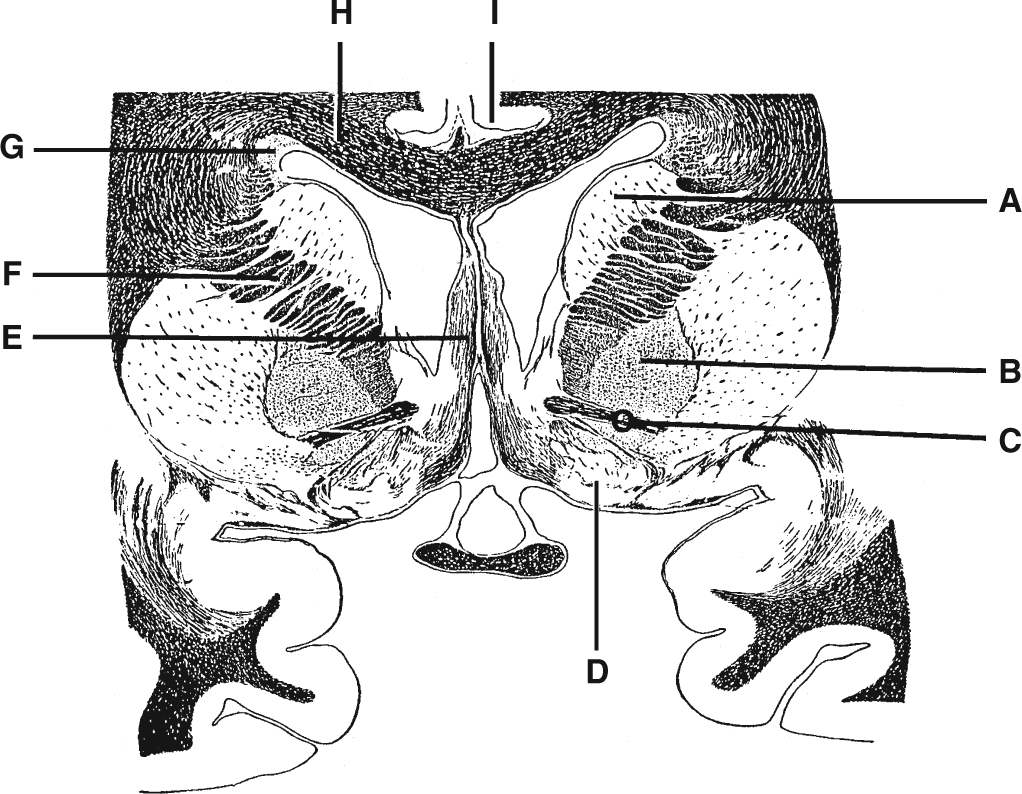357. A 78-year-old woman is found unconscious in her home and then is rushed to the emergency room of a local hospital. Upon waking, the patient is administered a neurological examination and magnetic resonance imaging (MRI). The patient is shown to have had some cortical brain damage from the stroke. Consequently, she has difficulty in understanding language and is diagnosed with a form of receptive aphasia. Which neurons in this figure project their axons to the region of cortex affected by the stroke?
358. A patient presents with a movement disorder later diagnosed as Huntington disease. She subsequently passes away and an autopsy reveals brain damage in the forebrain. Which structure displays the location of brain damage?
359. A young man receives a head injury in a football game, which later results in the development of seizure activity and the loss of his short-term memory. Which of the following is the most likely structure affected by this injury?
360. As a result of a vascular occlusion, a 64-year-old woman develops a homonymous hemianopsia. Which structure is most likely affected by this occlusion?
361. A 43-year-old woman has been complaining of difficulty in sleeping along with mood changes for several weeks. Following a neurological examination, it is determined that the patient has a small tumor present in her brainstem reticular formation that could account for her sleep and mood disturbances. One of the routes by which the reticular formation could influence functions of the cerebral cortex, such as sleep-wakefulness cycles and mood, includes parts of the forebrain. From which region do neurons play an important role in transmitting information from the reticular formation to widespread areas of the cerebral cortex?
Questions 362 to 368
For each vignette, select the labeled structure in the figure that is most likely affected. Each lettered option may be used once, multiple times, or not at all.

362. An elderly man suffers a stroke that is limited mainly to the globus pallidus, resulting in a hyperkinetic disorder. This is due mainly to the degeneration of fiber bundles that arise from the globus pallidus, which supply the ventrolateral (VL) and ventral anterior (VA) nuclei of the thalamus. Which structure is most likely affected by the stroke?
363. A 72-year-old man sustains a vascular occlusion involving a region of his forebrain. Afterward, he displays symptoms of dyskinesia, which is later diagnosed as hemiballism. Which structure is most likely damaged by the vascular occlusion?
364. A person has a stroke involving the ventral aspect of the diencephalon, resulting in significant damage to the mammillary bodies. As a result, there is considerable loss of input that normally supplies a major target region of the mammillary bodies. Which structure is now deprived of such input?
365. Concerning the patient described in Question 364, there is considerable degeneration in the major efferent pathway of the mammillary bodies. She also presents with disturbances in memory but otherwise appears relatively normal. Which structure is most likely damaged?
366. As a result of an injury involving the temporal lobe, a person suffers changes in personality and autonomic functions. These changes are due in part to the loss of input to the medial hypothalamus. Which structure normally transmits information from parts of the temporal lobe to the medial hypothalamus?
367. A 53-year-old man presents with an unusual constellation of movement disorders. These include choreiform movements at rest as well as intention tremors and poor coordinated movements. The neurologist who examines the patient concludes that the patient suffers from movement disorders characteristic of both the cerebellum and basal ganglia and is probably due to a small stroke that affected a structure related to both of these neuronal groups. Which structure in the diagram, if damaged, could account for the combined deficits seen in this patient?
368. A vascular lesion affecting a middle-aged woman results in the development of changes in affective responses and related aspects of emotionality, characterize by a flattened affect. The neurologist attributes the flattened affect to the loss of communication between the affected structure and the prefrontal cortex. Which of the structures is affected by the lesion?
Questions 369 to 375
For each vignette, select the labeled structure in the figure that is most likely affected. Each lettered option may be used once, multiple times, or not at all.

369. A 68-year-old man is taken to the emergency room after having a stroke while working in his office. Several days later, he presents to the emergency room with an upper motor neuron (UMN) paralysis of the right hand and right leg as well as a motor aphasia. An MRI indicates that the stroke involved structures situated within the forebrain. Which structure is most likely affected by the stroke?
370. A patient suffers from epilepsy for approximately 10 years and has been successfully treated with drugs. In recent months, the intensity of the seizures became significantly worse, spreading to both hemispheres of the brain, as drug treatment proved ineffective. In order to block the spread of the seizures, surgery is indicated. Which structure is now the subject of the surgical procedure?
371. A patient presents with a hypokinetic movement disorder. Both the neurosurgeon and the neurologist recommend a surgical lesion of the major output pathway of the basal ganglia in order to alleviate his condition. In which structure is the surgical lesion placed?
372. A new procedure is developed for the treatment of Parkinson disease. It involves the direct administration of dopamine, a dopamine agonist, or a dopamine precursor to the brain structure whose dopamine concentrations have been depleted as a result of the disease. Which structure receives delivery of these compounds?
373. A patient is sent to be examined by an endocrinologist after complaining of excessive thirst and increased excretion of urine. The patient is then referred to a neurologist and neuroradiologist, who detect the presence of a secondary brain lesion after viewing an MRI of the patient’s brain. Where is the most likely locus of the lesion that could account for these deficits?
374. After receiving a neurological examination, a patient is told that he is suffering from psychomotor seizures induced by the presence of a brain tumor. The patient also presents with an altered personality state characterized by marked irritability with heightened anger in response to circumstances normally considered to be innocuous. Where is the most likely locus of the tumor?
375. A patient is referred to a neurologist after complaining that he cannot see out of the right half of each eye. The examination, coupled with an MRI, reveals the likely presence of a brain lesion causing the right homonymous hemianopsia. Which structure is most likely affected by the lesion?
Questions 376 to 379
For each vignette, select the labeled structure in the figure that is most likely affected. Each lettered option may be used once, multiple times, or not at all.

376. A patient who was suffering from Huntington disease dies and an autopsy is performed. The neuropathologist notes marked degeneration in the forebrain. Which structure would be expected to show marked neuronal loss?
377. After displaying progressive memory loss over a period of several months, an elderly patient is referred to a neurologist, who concludes that the patient is suffering from Alzheimer disease. Several years later, the patient dies and an autopsy is performed, indicating a significant loss of cholinergic neurons in specific regions of the forebrain. Which structure most likely exhibited the greatest loss of cholinergic neurons?
378. A 47-year-old man begins to display marked involuntary movements at rest and a subsequent neurological examination reveals that he is suffering from a form of chorea. Chorea is believed to be due in part to a loss of GABAergic neurons in the neostriatum. Which structure normally receives major GABAergic input from neurons originating in the neostriatum but is now deprived of this input?
379. A 32-year-old man begins to develop erratic and unstable emotional behavior and is referred initially to a psychiatrist and then to a neurologist. A subsequent MRI reveals the presence of a tumor in a region that receives significant input from the hippocampal formation and which projects its axons to the hypothalamus. Which structure contains the tumor?
Questions 380 and 381
380. A 32-year-old woman visits a gynecologist after noting that her menstrual cycle had stopped. She further complains of headaches, which have become more severe over the past several months and also reports difficulty with her peripheral vision. Her gynecologist tells her that the level of the prolactin hormone is high and refers her to a neurologist. The neurological examination is normal except that the patient is unable to see fingers in the temporal fields (lateral half of each visual field) of both of her eyes. An MRI reveals the presence of a tumor. In which area would a tumor most likely cause a high prolactin level?
a. Adenohypophysis
b. Neurohypophysis
c. Amygdala
d. Hippocampus
e. Adrenal gland
381. In the patient from Question 380, which of the following types of visual loss will most likely occur?
a. Central scotoma
b. Superior quadrantanopsia
c. Bitemporal hemianopsia
d. Homonymous hemianopsia
e. Papilledema
382.
Stay updated, free articles. Join our Telegram channel

Full access? Get Clinical Tree







